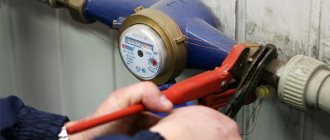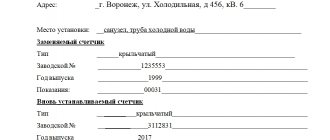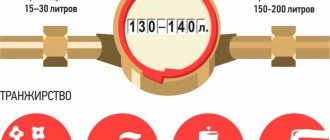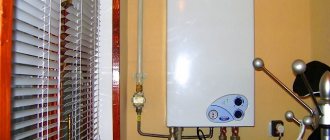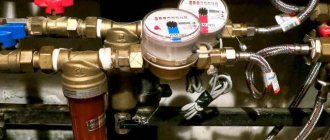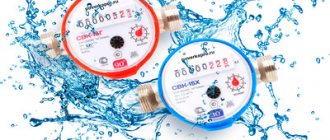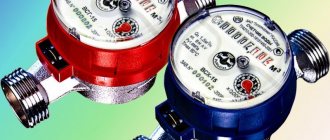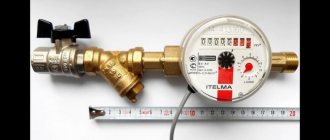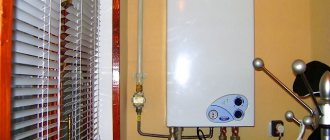To control water consumption, it is imperative to include devices for measuring water consumption in the water supply system, namely, install water meters with parameters that comply with current standards.
Agree that such a device will not only allow you to control real consumption and pay only for used water, but will also teach you how to save this resource.
But first you need to buy it and, following the rules for installing water meters, connect it correctly. We will look at how to do this in detail in the article. Here are the basic installation rules with visual photos of the individual stages of installing the device.
As a supplement to the main material of our article, we have selected video recommendations for self-installation of meters. After all, metering devices can be installed with your own hands, but with the permission of the services performing the sealing.
Types of meters and their features
Devices for recording water consumption in a specific residential building are installed on the communication networks of apartments and houses connected to centralized water supply systems.
Installation rules with a number of requirements and commissioning procedures have been developed for management companies. Although the installation, if desired, can be done manually.
When choosing water meters for insertion into water mains, a number of significant factors should be taken into account:
- condition of pipelines;
- presence of foreign inclusions in water : finely dispersed suspension and larger insoluble particles;
- material aspect - financial capabilities of apartment/house owners;
- nature of use of devices , stationary temperature of the working environment.
Depending on the sources of energy supply, two groups of water flow meters can be distinguished.
These are volatile, i.e. those requiring electricity to operate, and non-volatile, functioning due to the action of natural mechanical processes.
Image gallery
Photo from
Water flow meters
Meters for cold and hot water
Cold water meter
Conditions for operation of the DHW meter
Energy-dependent ones include electromagnetic, ultrasonic, and vortex. Their operating principle, based on the use of physical phenomena, is the basis of their name.
The list of power-independent devices includes tacheometric varieties.
Devices that record the volume of water consumption are installed at pipeline entries into apartments of multi-storey residential buildings and into private houses connected to the networks.
There is a division according to design into separate and compact types.
Water meters are divided according to the number of serviced water pipes into multi-channel, single-channel, and two-channel models.
Water flow measuring devices are installed on the hot and cold branches or only on the cold one. The meter can be installed only in heated rooms with lighting, the standard temperature value in which is in the range of +5 °C - (+50 °C)
Type #1 - induction (electromagnetic) meters
The device is not cheap, its service life is more than ten years, the operation of the device is based on the ability of water to conduct electricity. Used when there are no foreign inclusions in the water (scale, rust, etc.).
The quality of water and pipelines make it difficult to use in everyday life.
Such water meters are most widely used for monitoring water flows in the pharmaceutical, food, and brewing industries and for water metering of wastewater flows.
Electromagnetic water flow meters are installed at water intake stations, distribution facilities that provide water to an independent housing association, microdistrict or cottage community
Type #2 - ultrasonic meters
More expensive than electromagnetic ones, but has greater accuracy and service life (more than 15 years). The operating principle is based on comparing the propagation of ultrasound speed “with” and “against” the flow. Used for clean water and pipes, not widely used.
There are two types of ultrasonic water meters: Doppler and time-pulse. According to the installation method, they are divided into: those installed outside the water pipe (Clamp on) and those in direct contact with water or mortise (Insertion).
The main area of application is for recording the water consumption of industrial enterprises and the amount of waste water discharge.
Ultrasonic meters measure water flow as ultrasound passes through the flow being measured.
Type #3 - vortex counters
The operating principle of vortex metering devices is to detect vortices arising behind a “blimp body of a special shape” placed in the flow.
For example, if a certain object (a rod of a specific configuration) is lowered into the flow of the measured medium, then the resulting frequency of vortices on it, or as it is otherwise called the so-called “Karman track,” will become proportional to the flow speed, and therefore to the volumetric flow rate.
Simply put, vortex counters record the number of oscillations caused by the collision of a flowing medium with a relative obstacle, and convert this number into liters passing through the pipe.
Such devices have become widespread in operations for adjusting and monitoring technical processes. Their use is irrational in domestic conditions.
A device for measuring water flow must be selected in strict accordance with the purpose and parameters of the environment in which it must operate. Operating pressure parameters in the DHW and cold water circuits should not exceed 1.0 MPa
Type #4 - non-volatile (tacheometric) meters
Inexpensive meters with a service life of about five years, designed for equipping domestic and industrial water supply networks.
Among them there are modifications produced for operation in conditions of old water supply and questionable water quality aspects.
According to the location of the axis of rotation, they are divided into:
- vane - the axis is perpendicular to the flow;
- turbine - the axis is parallel to the flow.
The operating principle is based on recording the number of movements of the impeller or turbine. When water masses move, the main working parts of the devices rotate, which in turn sets the mechanical counter in motion.
The diameter of vane water meters is no more than 40 mm. They can keep track of water up to 15 cubic meters per hour. Turbine devices have a diameter of 50 to 100 mm; unlike previous ones, they have a much larger reading of passing water.
The accuracy of the readings is low, but the reliable design has been proven by many years of excellent work in water supply systems (apartments, houses, offices, etc.), which makes them the most popular.
The water flow measuring device is located at a distance of 0.3 - 1.0 m above the floor level. If water is supplied to the apartment via two or four risers located in different places, then two meters or two sets of meters are installed
According to the operating temperature range, meters can be for hot water (operating values t° up to +130 °C), for cold water (t° up to +30 °C) and universal (t° up to +90 °C).
They can be distinguished by color and nomenclature designation. Usually red SGV is produced for hot water. To calculate the flow of cold water, a blue cold water indicator is produced. There are also universal options - orange USV.
According to the principle of operation, water meters are divided into:
- Single jet . Water flows into the impeller or turbine in a single stream.
- Multi-jet . The water flow is divided into separate jets, used for large diameters over 40mm.
Based on the method of installing reading mechanisms, all types of mechanical devices can be divided into dry and wet. In wet ones, the counting mechanism stands in water, while in dry ones it is separated by a plate.
Tacheometric instruments for measuring water flow are the most common version of household water meters
Most apartment owners and homeowners whose homes are connected to centralized networks choose tacheometric water meters.
I am attracted by the availability of mechanical devices both in terms of price and availability. They can be found in almost any plumbing store. Tacheometric types of meters are easy to install and operate.
You may also find the information discussed in our other article useful, about the top ten counters popular among buyers.
Sample documents for registering water meters
The proposed forms of documents for replacing water meters are not mandatory. Many management companies have their own ways of designing the process. Therefore, it is better to familiarize yourself with them directly from these organizations.
The final act of registering the replacement of water metering devices in an apartment is sealing the meter.
Water meter installation technology
You can install a water meter yourself, or you can seek help from specialized institutions, a management company, or a structural department of a water utility.
When choosing a company, make sure it has a license and provides a warranty period of service, read the reviews.
If you do not trust the work to others and are confident in your abilities, then you can install the meter yourself, just first consult with specialists from the water utility to see if they will allow you to install the meter yourself; usually it is not prohibited.
Regardless of who will install the water meter, the procedure for installing a water meter will not change:
- Before starting installation, you must turn off the water in the riser. You should submit an application to the management company or, if you have a shut-off valve, close it yourself.
- It is necessary to determine the installation diagram of the unit and its position (vertical or horizontal).
- Then you need to connect the shut-off valve and the coarse filter (without plumbing winding) in such a way that the filter pipe with the mesh is directed to the bottom, determine the number of turns when twisting.
- Now you need to remove the filter again and completely assemble the entire assembly, taking into account the number of turns, using a winding.
All threaded connections are carefully wrapped with sealing tape and treated with plumbing mastic.
When assembling, pay attention to the water meter; there are arrow marks on it.
The direction of the arrows must coincide with the direction of water flow through the device, otherwise the operation of the installed meter will be incorrect, which is why the water utility representative will not accept such work.
It is important to ensure the required position of each element. In the direction of water flow, it looks like this: shut-off valve, coarse filter, water meter, check valve.
When installing, pay attention to the order of the elements in the assembly, it must coincide with the direction of the water flow
The next stage is preparing the pipeline for installation of the system. This is a rather pedantic process, since the length of the assembled unit must match the length of the segment on the existing pipeline with a minimum error.
Of course, you can use flexible eyeliner, but it doesn’t look aesthetically pleasing.
Before cutting out the pipe, it is advisable to place a basin or other container into which the remaining water in the system will be drained.
Depending on the pipes, it will be necessary to cut threads in the case of metal pipes or use fittings and an iron to solder propylene in the case of polypropylene pipes.
You may also find useful information about the rules for connecting plastic pipes to metal ones, which is given in our other article.
The final stage is the insertion of a water meter into the water supply system. We install the assembly we have assembled into the prepared system, and we need to seal all threaded connections using linen liner or Fum tape.
When tightening threaded connections, do not apply great force, as this can lead to the formation of microcracks and subsequent leakage. If everything is done correctly, then there will be no leaks when water is supplied, you can proceed to installing the seal.
Insertion into the system using a flexible connection is less labor-intensive, but more expensive
Legal requirements
The installation of metering devices, their commissioning and consumption calculation standards according to their data are regulated by legislative acts:
- No. 102-FZ (from 2008) - regulates the general characteristics of PU, prescribes the rights of users to the accuracy of measurements when calculating utility services.
- No. 416-FZ (of 2011) - prescribes the procedure for legal interactions in the field of water supply.
- Government Decree (GD) of the Russian Federation No. 776 (of 2013) regulates the rules for accounting for water consumption and wastewater disposal using water meters.
- RF PP No. 306 (from 2006) - it provides water consumption standards.
- RF PP No. 354 (of 2011) – calculation of payment for the resource consumed according to the indications of the PU.
- Federal laws regulating the rules for measuring consumed energy resources, installation and introduction into use, the rights of citizens to the accuracy of measurements (No. 102-FZ and No. 261-FZ, dated 2008 and 2009, respectively).
- Order of the Ministry of Energy, which strongly recommends the use of PU for measuring consumption (No. 178, effective April 16, 2010).
- RF PP No. 344 (of 2013) - increases increased calculated coefficients for citizens who do not install PU without good reason.
Seal installation and technical documentation
After you have installed the metering unit and checked that it is working properly, the question arises, how to properly seal the water meter? You should find out who is doing this, whether it is possible to put a filling yourself.
You should entrust the installation of the seal to specially trained people: representatives of the water utility or the management company. To do this, you must submit an application to receive a meter.
Do not hesitate to apply, despite the installed meter, water consumption will still be determined at the maximum before official registration.
And you will be able to pay the meter only after completing the official sealing procedure. Information on how to do this correctly is described in detail in our other article.
Installing a filling is a free procedure . You shouldn’t install it yourself; you’ll still have to call a representative of the management company.
Within some time, usually from three to five days, a local government representative will be sent to respond to your application. For normal working contact with him, you must have a verification certificate and a meter passport with you.
The specialist’s responsibilities include checking the correct installation order of the water meter unit and all its components, and also checking the integrity of the unit elements.
The water utility representative does not have the right to control the qualifications of the person installing the meter.
After checking and sealing the unit (with his own seal), the inspector will draw up a commissioning report, where he will enter the initial meter readings and provide you with a service agreement.
After carefully reading the contract, making sure that you are satisfied with everything, put your signature.
It is not allowed to use data taken from the meter in utility bills if a seal is not installed or there is no polymer film with a verification stamp printed on it.
After signing the contract, you begin to pay for water according to the meter. Among the documents, the owners should have one copy of the service agreement and the act of putting the meter into operation.
It is also necessary to leave a technical passport and a certificate of verification of the water meter. An employee of the management company will need a technical passport; it is better to make a photocopy in advance.
There are times when re-filling is required. For example, the service life of the devices has expired, one of the elements of the unit has broken, or a new element has been added to the system.
Therefore, it is better to store documents separately from other papers, so that in case of an unforeseen situation they are at hand.
Preparation for installation work
Procedure before installing the IPU:
- All necessary devices and components are purchased and mounting space is freed up. It is advisable to agree on the installation site in advance to avoid problems. It is important to choose the right water meter: according to SNIP 04.01-85, the placement of the mechanism must take into account the sensitivity threshold. Therefore, you should pay attention to the designation: symbol B (B*H) - the product must be placed horizontally, A (A*V) - vertically. If both options are present, then the IPU is universal.
- When a new device is introduced into the system, the inlet shut-off valve should be checked. If the ball valve is working properly, then there is no need to coordinate the installation, but you need to write an application to the service company to invite a specialist to put the IPU into operation. If it is impossible to completely shut off the water or when replacing part of the system, it is necessary to agree on the time to turn off the riser. This is not required if a plumber from a home maintenance company is hired to do the work.
- It is also necessary to contact the Criminal Code when reinstalling the mechanism. The specialist will take readings, after which the filling can be removed.
On a note! DHW IPUs are universal and suitable for installation on all pipes, but cold water meters can only be used for cold water.
Problems during operation and their solutions
During the operation of the water metering unit, some problems may arise. Let's consider their types and possible solutions.
Whatever the problem, it is not recommended to fix the problem yourself. Use the services of specialists - this will save your time and money.
High-quality sealing is the key to long-term service, but do not overdo it. A large amount of winding may cause leakage
Calling a plumber to your home is much safer and more expedient, since the problem can concern completely different parts of the water meter unit. For example, the fault may lie in pipe connections. The coarse filter often becomes clogged; it needs to be cleaned or replaced. Breakage of the shut-off valves cannot be ruled out. In addition, contacting a plumber will help solve all problems several times faster. In most cases, the service is not that expensive or even free. Proper troubleshooting of the water meter unit will prevent further damage to the equipment and avoid further problems in the future.
Symptoms and corrective measures:
- Water flows poorly through the water meter . The coarse filter may be clogged. It is necessary to call a representative of the management company to eliminate the defect; he is obliged to clean the filter and re-seal it free of charge. Under no circumstances do this yourself; breaking the seal is tantamount to voiding the warranty.
- Broken seal. Don't fix it yourself. Notify the management company as soon as possible. You will have to pay for re-sealing, but this is nothing compared to the fines if the inspector discovers that the seal has been broken. You will have to pay the full amount of the tariff since the last inspection (maybe several years), as well as a fine for missing an application.
- Water passes through the water meter, but the readings are not recorded. The counting or rotor mechanism may have broken down. If you are sure that your water meter is faulty, you have the right to a free unscheduled inspection. This is the case if the warranty period has not expired.
During the inspection period, water payments are calculated based on the average minimum for the region. The inspection can take up to several months; sometimes it is easier to buy a new one.
Don’t delay installing a water meter - it will help you save up to 30% of your monthly payment
Installing individual water meters is becoming an integral procedure in every home; the process is not so much labor-intensive as it is troublesome, but it is completely worth it.
By following the order in the sequence of work on installing a water meter, you not only save about 30% every month, but also have an incentive to use water wisely.
You may also find useful information about the timing of meter verification and the specifics of this procedure.
Cost of the procedure
Residential real estate can be privately or municipally owned. In the first case, the owner will have to pay for the installation of the water meter himself. On average, such a service will cost 4-7 thousand rubles, in this case it all depends on the region, as well as on how difficult it will be to install the device. If the apartment is municipal, installation is free.
Now about the price of the device itself. You can buy it yourself at the appropriate store or purchase it at the Criminal Code. The average price will be about 2.5 thousand rubles. But again, it all depends on the manufacturer’s product model.
Conclusions and useful video on the topic
The video will clearly present the process of assembling units for installing cold and hot water measuring instruments:
The clear conclusion is that installing meters is beneficial for every family, since water becomes more and more expensive every quarter, and the supply of clean fresh water becomes less and less.
Installing a meter yourself or calling a specialist is a personal matter. As can be seen from the step-by-step instructions given in our article, you can perform the installation yourself by carefully studying the general recommendations and purchasing a meter and components that will be useful during the installation process.
And although a representative of a water supply company during sealing has no right to be interested in the qualifications of the technician installing the metering device, in practice users are faced with different situations.
If you have any problem during sealing or want to share your installation experience, please leave your comments under this article.
Is it profitable or not to install water meters in an apartment?
There is no longer any need to think about whether a water meter is needed or not - a law has been passed according to which everyone is required to install one. But many people wonder how profitable it is. If there are as many people living in the apartment as registered or less, installing a meter is beneficial. It is also beneficial if, say, someone moves to a dacha for the summer or spends a vacation there. If the situation is diametrically opposite - fewer people are registered than live, it is not profitable for you to install a meter. But there is no escape from this.
You only pay for what you use
How big the savings will be for permanent residence depends on the calculation method adopted in your management campaign and how intensively you use water. At a minimum, you will save about 30%, but there have been cases when payments after installation were reduced significantly. This may happen if the house has a common meter. In this case, based on the results of the month, the consumption of those residents who have meters installed is subtracted from the total readings, and the remainder is divided among the remaining apartments according to the number of registered people. Usually those who actually have more people living with them than registered do not install meters. In this case, the monthly consumption per person can be 8-10 cubic meters of cold and approximately the same amount of hot water. In fact, even if you don’t save much, you get about 3 cubes of cold and 2 hot. So it really does make sense.
Consumer Reviews
Frequent questions that arise on forums about installing PU water concern the eligibility of self-installation.
Discussions are replete with reports that despite the legality of independent actions, some unscrupulous organizations refuse to accept work . Lawyers urge to fight, citing laws.
Another common topic is finding an organization that will carry out the installation. Most reviews point out the disadvantages of rudeness, unpunctuality of the craftsmen, as well as unexpectedly increased prices compared to those negotiated over the phone.
As for the issue of using the meters themselves, the reviews here are divided into two diametrically opposed camps: some complain about the uselessness of the purchase, since there is no savings and the extra expenses are endless, others are delighted and give specific figures for the savings.
